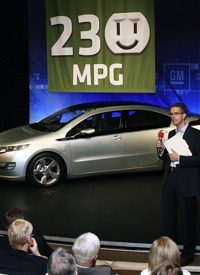
Now that the Chevy Volt, General Motors’ electric car, is about to arrive in selected dealers’ showrooms around the country, it has been getting a lot of press. Some are puff pieces, one of which appeared in USA Today, while others are much more critical.
According to James Healey of USA Today, the Volt “represents a staggering amount of engineering … which combines an electric motor … and a small gasoline engine to create a drive train that uses no gasoline for 25 to 50 miles, [and] then sips it.” Healey went on to say that the Volt was quiet, “steered nicely,” and stopped promptly. He did mention the 400-pound battery tucked away underneath the car that limits passengers to four, and allows just 10 cubic feet of storage. He also indicated that it would take at least eight hours to charge the battery, and that the charge would last for only about 30 or so miles before the gas “generator” kicks in.
The vehicle weighs in at just under two tons. All of this for $41,000 including shipping, “but some buyers will qualify for a federal tax credit up to $7,500 as well as state and local ‘clean-car’ incentives.” He never did say anything about the 230 mpg promised by GM back in August of 2009.
GM was so certain of the 230 mpg number that they designed a logo using the numbers 2, 3 and 0 with an electrical outlet as part of the initial marketing campaign. Reality set in, however, when GM released copies of the Volt to 150 journalists last month, including ones from Popular Mechanics, Motor Trend, Edmunds.com, and Car and Driver. In actual road tests, the best mileage was obtained by Autoblog at 47.5 mpg while Car and Driver reported a much more pedestrian 26 mpg. These numbers were far off the mark from GM’s figures. GM estimated their own “city fuel economy rating” of 230 mpg plus another 25 kilowatt-hours per 100 miles. GM claimed that they used the EPA’s “proposed method” for evaluating hybrids, but the EPA stated that the “EPA has not tested a Chevy Volt and therefore cannot confirm the fuel economy values claimed by GM.” At this writing, GM is still waiting to see just how the EPA will rate the car.
There are additional costs to “going green.” If a homeowner doesn’t want to wait eight to 10 hours for the car’s battery to recharge, he can purchase a home charging unit that provides 240 volts which cuts that time in half. The cost is $500 plus installation. However, Consumer Reports noted that homeowners would likely be required to pay more than that if their home doesn’t meet the U.S. National Electrical Code and needs to be upgraded. That could add an additional $1,500 to the owner.
The gas “generator” requires premium fuel. And by the time all energy usage is calculated, the Volt is about as energy-efficient as a BMW 118d (their “clean diesel” model), and measurably less efficient than the high-end Tesla Roadster.
The potential for profit is bleak. Ford is offering a plug-in version of its Focus, on which it loses over $1 billion a year. Editors at Investors Business Daily had a chance to drive one of the new Volts, and were singularly unimpressed. Initially calling it an “electric Edsel” (in memory of the unlamented 1958 Ford Edsel, considered one of the 50 worst cars of all time), IBD said, “Now that it’s about to hit the road, nothing revealed has changed our mind.” Advertised as an all-electric car, it turns out,
It’s not an all-electric car, but rather a pricey $41,000 hybrid that requires a $7,500 subsidy to get car shoppers to look at it….
In 2008, candidate Obama pledged to put 1 million plug-in vehicles on the road by 2015. Not likely. It was a tough sell when we thought it was all-electric and could get 230 mpg. It will be a tougher sell now that we find it’s [just] a glorified Prius with the price tag of a BMW that seats only four because of a battery that runs down the center of the car….
This is what happens when government picks winners and losers in the marketplace and tries to run a business.
The Presidential Task Force on the Auto Industry said that “GM is at least one generation behind Toyota on advanced ‘green’ powertrain development … [and] while the Chevy Volt holds promise, it is currently projected to be much more expensive than its gasoline-fueled peers and will likely need substantial reductions in manufacturing cost in order to become commercially viable.”
If GM’s experience is the same as Ford’s and it cannot sell enough Volts to turn a profit, the company can always look to its biggest shareholder for help: the U.S. taxpayer.
Photo: AP Images



